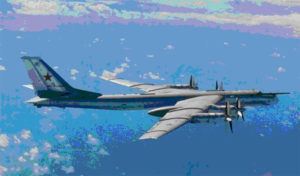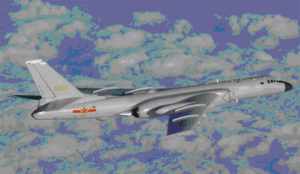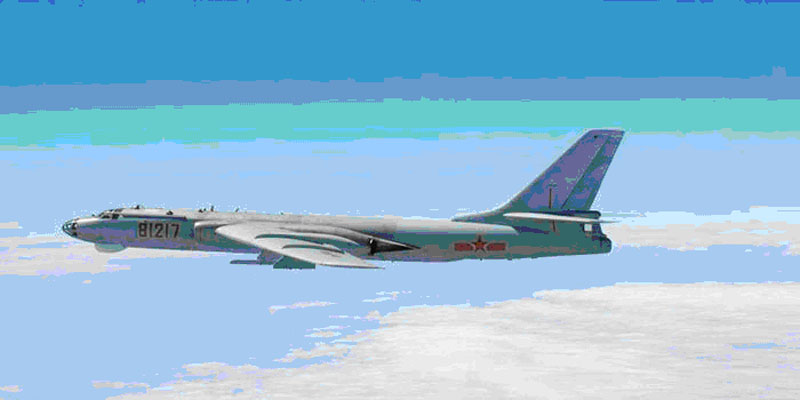Joint Exercise With Russian Planes Highlights The Limitations Of China’s Bombers
Dec 28, 2020
A Chinese H-6 bomber over the Western Pacific Ocean, October 27, 2013 Reuters
- Shorter range and smaller payloads than Russian and US bombers mean China’s aircraft cannot be viewed as long-distance strategic bombers.
- But China is developing next-generation bombers to extend its military reach and give it an intercontinental capacity.
A joint patrol between China and Russia has underlined shortcomings of Chinese bombers that could hold back Beijing’s ambitions, analysts have said.
Four Chinese H-6Ks and two Russian Tu-95s took part in a joint patrol over the western Pacific on Tuesday as part of an annual programme of military cooperation, China’s defence ministry said.
The exercise was meant to show solidarity between the two nations as they both face sanctions and pressure from the United States.
However, the Chinese bombers have limited range and payload compared with their Russian counterparts, and analysts said the contrast had implications for China’s capabilities.
The Chinese air force has 160 to 180 H-6 bombers, among the most advanced in China. They have a range of 6,000 km (3,728 miles) and a wing loading of 160 kg (353 lbs) per square metre. Among all the H-6 bomber variants, only the H-6N variant is capable of being refuelled in the air, resulting in a clear range weakness.
The Russian Tu-95 is a strategic bomber and missile platform with a range of 15,000 km and a wing loading of 606 kg per square metre.

A Russian TU-95 bomber. Handout
China is developing its next-generation H-20 bombers — subsonic stealth bombers designed to give the country an intercontinental capacity, expanding its reach far beyond its seaboard.
The H-20, designed to carry four stealth or hypersonic cruise missiles, has an estimated range of about 8,500 km and a payload of 45 tonnes.
Russian strategic bomber the Tu-160 has a range of 12,300 km and a wing loading of 742 kg per square metre, while the American supersonic bomber the B-1 Lancer can fly 9,400 km with a wing loading of 820 kg per square metre.
Jon Grevatt, a warplane specialist and Asia-Pacific defence analyst at defence industry publisher Janes, pointed out that the limitations in range and payload of the Chinese H-6 bombers would reduce China’s ability to flex its muscles.
“The Chinese H-6 bomber is based on a very old Russian bomber called the Tu-16 Badger, which was introduced in the 1950s,” he said. “Although China has updated it, it’s basically still a very old design.”
“Chinese bombers cannot fly as far without refuelling and cannot carry as heavy a payload as Russian and US bombers.”
During Tuesday’s exercise, the six Chinese and Russian bombers entered the air defence identification zone around the South Korea-controlled Dokdo Islands, which are also claimed by Japan. Both nations scrambled fighter jets to track the Russian and Chinese bombers.

A Chinese H-6 bomber during a joint operation with Russian aircraft over the East China Sea and Sea of Japan, December 22, 2020. Japanese Ministry of Defense
According to a photograph taken by the Japan Air Self-Defence Force, China deployed a new variant of the H-6K bomber with eight wing pylons instead of the six commonly seen in H-6 bombers.
Song Zhongping, a former Chinese military instructor, said the two pylons near the tips of the wings could be used to carry light weapons such as airborne electronic jamming pods, while the other six pylons could carry heavier bombs or missiles.
A jamming pod is an electronic device designed to trick or deceive radar, sonar or other detection systems.
But Song said a lack of stealth capability made it difficult for Chinese bombers to penetrate foreign defence systems. “The H-6 bombers cannot be seen as true long-distance strategic bombers,” he said.
The first China-Russia long-range joint air patrol in the Asia-Pacific region was held in July last year, and triggered hundreds of warning shots from South Korea and a strong protest from Japan.
Grevatt said the joint patrol could help China enhance its military tactics and collaboration between air forces.
“It can also send out a strategic message to the United States that China and Russia are willing and able to collaborate,” he said.
Courtesy: Business Insider/South China Morning Post

